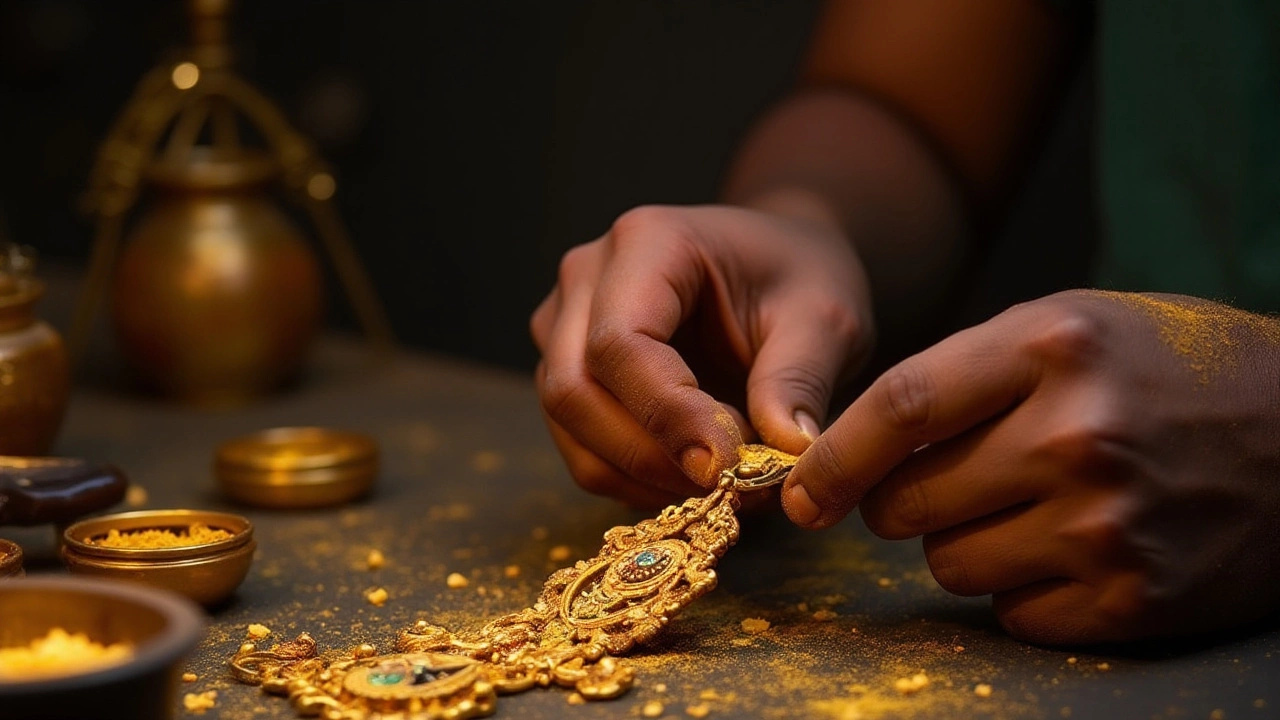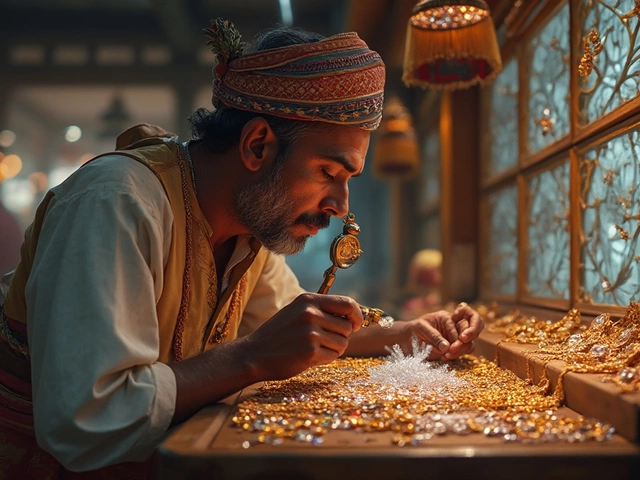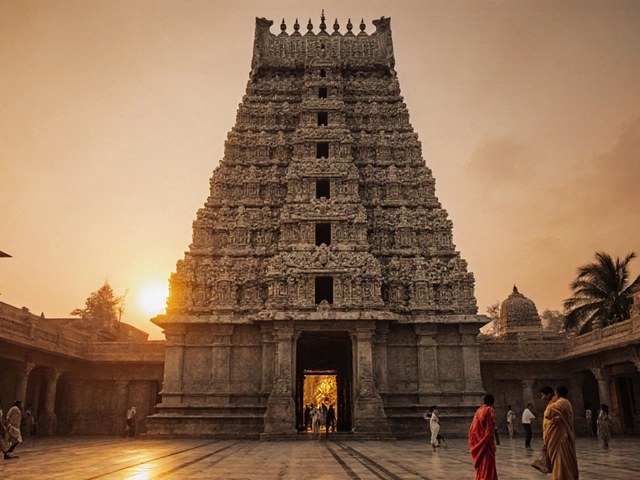
Amidst the vibrant tapestry of India's cultural heritage lies a shimmering treasure known as Nagas gold. This enigmatic form of temple jewellery has been a cornerstone of artistic expression and spiritual devotion for centuries. Each piece, crafted with meticulous attention to detail, tells a story of tradition and reverence.
At the heart of Nagas gold jewellery is a harmonious blend of age-old techniques and religious symbolism. These exquisite masterpieces adorn temples, deities, and devotees alike, playing an integral role in cultural festivities and rituals. Yet, beyond its spiritual significance, Nagas gold has found a place in contemporary fashion, captivating the hearts of those who cherish its timeless beauty.
In this exploration, we delve into the origins and craftsmanship behind Nagas gold, unravel its intertwining with India's rich religious tapestry, and uncover how this ancient art form continues to inspire and adapt in the modern world. Whether you are a collector, an admirer, or someone simply curious, the world of Nagas gold offers a journey into a heritage of elegance and devotion.
- The Origins of Nagas Gold
- Craftsmanship and Design
- Religious and Cultural Significance
- Nagas Gold in Modern Times
- Caring for Nagas Gold Jewellery
- Collecting and Investing in Nagas Gold
The Origins of Nagas Gold
The shimmering allure of Nagas gold is steeped in the rich tapestry of India's past, weaving together myths, legends, and the sacred rituals of ancient temples. This unique style of jewelry is deeply entrenched in the history of South India, where temple traditions have long celebrated the divine through beautiful art. Possibly dating back to the Chola dynasty, which reigned during the medieval periods, these artisans carved out a niche that stretched beyond mere adornment. They aimed to channel blessings and prosperity, embodying the gods' grace in the ornaments displayed both on statues and devotees.
An intriguing aspect of Nagas gold is its stylistic roots, which are believed to have taken form under the skilled hands of the goldsmiths of Tamil Nadu and Karnataka. These craftsmen, inspired by the environment and the deities they worshiped, would transform pure gold into detailed and grandeur pieces. They incorporated elements such as serpents or 'Nagas' — mythical creatures known for their divine bearing in Hindu scripture — not only naming the style but also infusing it with stories of protection and wisdom. There was always a spiritual dimension to what they created, manifesting a connection with the divine.
"The history of gold jewelry in India is not just a history of fashion, but a spiritual and social narrative carved in gold," says renowned historian Priya Venkat. This thought captures the essence of the Nagas gold tradition where each piece is a storyteller, leading us through a cultural journey stretching overseveral epochs.
During the time of temple builders such as the Pallavas, Cholas, and later the Vijayanagara Empire, the craft of Nagas gold flourished as temples became the nucleus of community life. These temples commissioned large pieces of gold jewelry, not just to adorn the gods, but to serve as communal treasuries. The craftsmanship evolved throughout the 10th to 16th centuries, nurturing a unique visual lexicon that defined splendor and divinity through carvings of deities, animals, and ornate motifs. The traditional designs continue to capture this heritage, echoing through the aisles of cultural exhibitions and modern showcases alike.
Today, as we trace the journey of Nagas gold, it's evident that the art form adapted over the generations while preserving its original elements. Present-day artisans still use some traditional techniques passed down through families. The fascination with Nagas gold can be attributed to its dual nature: a tangible piece of history and an evolving symbol of the sublime. Collectors and enthusiasts of temple jewellery see it not merely as an accessory but as a declaration of cultural values and shared identity.
Craftsmanship and Design
The creation of Nagas gold jewellery is a mesmerizing dance between artistry and devotion, where skilled craftsmen and artisans breathe life into metal. These artisans, often inheriting this ancient craft through generations, dedicate their lives to preserving age-old techniques that date thousands of years back. The process of crafting begins with selecting the finest quality gold, known for its purity and brilliance, making Nagas gold jewelry not only a symbol of beauty but also an emblem of opulence. The gold is then meticulously shaped and molded into intricate designs, each pattern telling its own unique story.
The hallmark of temple jewellery India is its elaborate motifs inspired by divine mythology and nature. Artisans draw upon religious symbols such as deities, floral patterns, and geometric shapes, seamlessly blending them into mesmerizing creations. Every curve, every embellishment is a testament to the skill and precision of the craftsman. Techniques like 'nakshi' which involves intricate carvings and 'kundan' where gemstones are artistically embedded, add layers of depth and richness to the jewelry. These traditional methods require practiced hands and an unyielding patience, as each piece can take months to complete.
In an era of machinery and mass production, Nagas gold jewellery remains untouched by time, continuing to thrive on human touch and ingenuity. This commitment to craftsmanship is captured beautifully in a quote by renowned art historian,
"Each piece of Nagas gold is not merely an accessory but a shrine of dedication and centuries-old wisdom."The marriage of traditional and modern designs has seen these pieces ascend to new heights in global dynastic trends. Today, while retaining its cultural symbolism, such jewelry also finds itself enmeshed in the fashion-forward wardrobes worldwide, serving as both traditional and contemporary statement pieces.
Understanding the nuances of Nagas gold entails appreciation of the painstaking manual processes, from sketching designs onto paper to hammering folds and finally polishing. Artisans wield age-old tools, such as the 'punch' and 'hammer', rhythmically shaping the gold to their vision. Studying these artisans at work transports you to a world where time seems to stand still, every tap and stroke resonating the pulse of Indian culture. This dedication is the bloodline of Nagas gold’s exquisite allure, a timeless artistry that commands respect and admiration across borders.
As interest in sustainable fashion grows, Nagas gold jewellRy holds a unique appeal, as the long-lasting nature of gold coupled with recycled practices preserves the environment. Many collectors today invest in these timeless treasures not just for their aesthetics but for their ethical value as well. Investment-worthy pieces like these not only grow in financial value but also in cultural and historical significance, embodying a legacy that one can pass down through generations.
The designs crafted are not arbitrary; they follow certain auspicious guidelines based on centuries-old scriptures and astrological influences. Artisans often work alongside spiritual advisers, aligning their creativity with celestial patterns believed to bring prosperity and protection to the wearer. The complexity and significance infused in each design justify why Nagas gold is embraced not merely as an ornament but rather as a cultural saga etched in gold.

Religious and Cultural Significance
The allure of Nagas gold is deeply entrenched in its religious and cultural significance, offering a bridge between the tangible and the divine. In India, where spiritual artistry meets the glamor of goldsmithing, this special variety of temple jewellery holds a hallowed place. Nagas gold is often associated with the divine, crafted specifically to adorn deities in temples. The intricate designs and the artisanship represent the devotion of both the creator and bearer, transforming what would simply be metal into a symbol of spiritual grandeur.
For centuries, specific motifs such as serpents, peacocks, and deities have been meticulously carved into Nagas gold pieces, each symbol carrying layers of meaning that resonate with Hindu mythology and religious beliefs. The serpent, for instance, known as 'Naga' in Sanskrit, represents fertility, protection, and rebirth—a perennial symbol that bestows its name to this gold. Cultures around India revere these motifs not just for their aesthetic appeal but for their profound connectivity to legendary lore and spiritual contexts. Entire communities of artisans have thus dedicated themselves to preserving these meanings through their handiwork.
More than just statement jewelry for deities, Nagas gold pieces make frequent appearances in religious ceremonies, weddings, and significant cultural festivals. For those donning Nagas gold during such events, it's more than an embellishment; it’s an embodiment of faith compact in a resplendent form. The jewellery often has an element of auspiciousness attached to it, thought to bless the wearer with prosperity, peace, and divine vigilance.
"Nagas gold is not just decoration but a testimony of devotion refined by the flame of artistry," says renowned Indian art historian Devi Chandrasekaran, capturing the sentiment of many who cherish these golden wonders.In many states, these jewels are passed down as family heirlooms, ensuring that their sacredness persists from one generation to the next, making each piece not just an object of adornment but also a custodian of personal and cultural narratives.
In reflecting on the number of festivals and rituals that incorporate Nagas gold, a study by a cultural institution highlighted that more than 60% of traditional South Indian temple festivals include the use of such gold ornaments. Introducing a format that includes a fusion of worship and wealth, these ceremonies showcase the strength of Nagas gold as a part of India’s cultural fabric. It embodies a richness that transcends materiality, merging the physical realm with the eternal, a luminous testament to an age-old faith that prevails to this day.
Nagas Gold in Modern Times
The timeless allure of Nagas gold has gracefully transitioned into contemporary times, finding a unique niche in the realm of fashion and cultural expression. Its adaptability is a testament to its enduring charm. In an age where vintage meets vogue, Nagas gold is not only cherished for its ornamental value but also for the stories it holds. Jewelry designers today often draw inspiration from its traditional motifs, repurposing them into exquisite pieces that resonate with modern aesthetics. This elegant fusion of the old and new has made Nagas gold a staple among those seeking pieces that embody both tradition and modernity.
Markets across India and beyond have seen a surge in demand for temple jewellery. This renewed interest can be credited to the growing appreciation of artisanal craftsmanship and sustainable luxury. Artisans, who once exclusively crafted jewelry for temples, now see their work gracing fashion ramps and red carpets. A shift towards bespoke and meaningful fashion has turned the spotlight onto Nagas gold, with many wearers choosing it to symbolize cultural pride or a connection to their heritage.
The influence of Bollywood and South Indian cinema has further popularized Nagas gold. Celebrities frequently adorn themselves with these stunning pieces during festivals and award ceremonies, sparking trends that resonate with fans and fashion enthusiasts. The cinematic portrayal of traditional Indian themes often emphasizes the rich tapestry of the country's cultural and artistic heritage, with Nagas gold playing a significant role in showcasing this elegance. "Nagas gold represents a timeless connection to our past and a beacon for the future," remarks a well-known fashion critic in Vogue India.
"In this global village, it is a bridge that connects the worlds, showcasing India's artistic treasures to discerning wearers everywhere,"they added.
As digital marketplaces continue to expand, the availability of Indian gold jewelry to international buyers has increased. Online platforms offer detailed insights into the craft, providing potential buyers with a deeper understanding and appreciation of what they are purchasing. Virtual tours and interactive sessions with artisans add another layer of engagement, offering a personal touch to the digital shopping experience. For collectors and enthusiasts, this modern accessibility is a boon, enabling them to acquire pieces that are rich in history and cultural significance, no matter their location.
The investment potential of Nagas gold cannot be understated. As a form of gold jewelry steeped in history, it tends to appreciate over time, making it a valuable addition to any portfolio. Given its ties to cultural heritage, its worth often extends beyond monetary value. Owning a piece is akin to owning a fragment of a storied past, a narrative that continues to evolve as it charms new generations. Whether for its financial merit or its timeless beauty, Nagas gold remains an attractive proposition for both seasoned collectors and those new to the world of jewelry.

Caring for Nagas Gold Jewellery
Caring for Nagas gold jewellery is an essential aspect of maintaining its shine and splendor for generations. This jewelry style, rich in tradition and meticulous craftsmanship, requires a certain level of attention and specific care practices that ensure it remains as magnificent as the day it was crafted. Proper care not only preserves its aesthetic charm but also retains its cultural value and emotional significance. Ensuring your Nagas gold jewellery shines bright involves several thoughtfully observed practices, a routine that is as much an art as the creation of the piece itself.
First and foremost, it is crucial to regularly check for any signs of wear or damage, such as loose settings or dulling of the Indian gold jewelry. Though robust, temple jewellery often features delicate designs that can snag or bend with improper handling. Cleaning the jewelry requires a gentle approach; abrasive materials or harsh chemicals can deteriorate and damage the intricate patterns. Instead, opt for a mild soap and lukewarm water solution, gently scrubbing with a soft brush to reach grooves and intricate designs often found in temple jewellery India. Be sure to rinse thoroughly and pat dry with a soft cloth to avoid water spots, which could mar the gold's pristine surface.
Storage is another pillar of preserving Nagas gold's integrity. It's advisable to store each piece individually, ideally in a soft-lined box or a cloth pouch, to prevent scratches or oxidization. Direct sunlight and moisture are adversaries, known for causing tarnish or loss of luster. Therefore, keep jewelry away from direct sources of light and moisture. Better yet, utilize silica gel packs in storage containers to absorb excess humidity, particularly useful in more humid climates where moisture is a prevalent concern.
In addition to these basic steps, regular professional inspections by a trusted jeweler can provide a comprehensive assessment of your Nagas gold pieces. Jewelers can detect and rectify issues imperceptible to the untrained eye, thus extending the life of the jewellery. Interestingly, routine appraisals not only help in maintenance but can also ascertain an update on the value, an invaluable benefit for collectors and connoisseurs. According to a notable Indian jeweler, "Professional care can often unveil hidden beauties and preserve what time may seek to conceal."
Moreover, avoid wearing Nagas gold jewellery during heavy physical activities, swimming, or when applying cosmetics and perfumes. The chemical compositions in perfumes and oils can cause a chemical reaction, dulling the surface shine. When dressing, wear your Nagas gold pieces last to minimize contact with such substances. If accidental exposure occurs, ensure immediate cleaning to avert prolonged damage.
Effective care practices not only safeguard these exquisite pieces but act as a bridge connecting generations through their timeless allure. The importance of such attention is not simply about aesthetics; it encapsulates reverence for the past, pride in owning a piece of cultural heritage, and the joy of passing it onto future generations intact. By tending to your Nagas gold jewellery with both care and respect, you celebrate an eternal bond with tradition and elegance that transcends time.
Collecting and Investing in Nagas Gold
Navigating the realm of collecting and investing in Nagas gold is akin to embarking on a treasure hunt, abundant with heritage tales and opulence. Acquiring these intricately designed pieces is more than just a financial investment—it's a pursuit that connects one to a storied past, steeped in spiritual and cultural resonance. As demand for these artisanal masterpieces grows, understanding their value proposition can help collectors and investors tap into not only their aesthetic appeal but also their potential for financial appreciation. With each piece being unique, collectors often look for rare designs or historical significance, making the process exciting yet rewarding.
In the world of temple jewellery, authenticity is gold's finest ally. Provenance tracking is vital, which not only guarantees a Nagas gold piece's origins but also safeguards its cultural integrity. These jewels often boast exquisite craftsmanship, featuring motifs such as deities, flora, and fauna that are emblematic of India's rich iconography. For investors, it's essential to engage with reputable jewellers and artisans who are well-versed in traditional methods, ensuring their acquisition holds its value over time and adheres to authentic production techniques.
Understanding the Market Dynamics
The market for Nagas gold jewellery is steadily expanding, with a vibrant mix of connoisseurs and new collectors driving demand. As awareness spreads globally, many invest not only for financial returns but also as custodians of a glorious heritage. The pricing for Nagas gold can vary significantly based on factors like craftsmanship, weight, and historical context. Lady Lugia Montefiore, a noted jewellery historian, once said,
"The allure of Nagas gold lies in its ability to transcend time, offering both traditional charm and modern appeal in a single stroke."This demonstrates Bewise's timeless value in both cultural and economic landscapes.
When venturing into collecting or investing, examining existing market trends can be enlightening. Some collectors might prefer vintage pieces, which tend to fetch higher prices due to their rarity and age. Meanwhile, newer creations, crafted by master artisans carrying forward their ancestral skills, offer a fresh perspective with innovative interpretations. A strategic balance between these two options potentially provides a robust investment portfolio, catering both to the laurels of the past and the innovations of the present.
Prudent Purchasing and Maintenance
Proper care and maintenance of Nagas gold jewellery can greatly impact its longevity and continued value. Using soft, non-abrasive materials for cleaning and storing pieces in climate-controlled environments can prevent damage over time. Keeping detailed records of purchases, including photographs and documentation of provenance, enriches records and can augment the perceived value when reselling or appraising pieces. Additionally, affiliating with gemologists or experts in temple jewelry might provide extra assurance, ensuring each piece is an authentic representation of its storied origins.
As the global appreciation for Indian temple jewellery continues to soar, collecting and investing in Nagas gold represents not just a financial decision but a commitment to cultural preservation. By treasuring these unique pieces, collectors enable future generations to experience the dazzling fusion of spirituality and artistry encapsulated in each jewel. Through both discernment and passion, your endeavour as a collector not only bolsters financial gains but also joins a legacy that echoes with the clangor of traditions as old as time itself.




